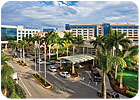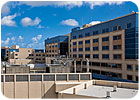
Memorial Healthcare System administrators were concerned. The management of MHS, a family of six hospitals based in South Broward County, Fla., knew they’d dodged a bullet. While Hurricane Wilma, one of the deadly Florida storms of 2005, struck hardest 150 to 200 miles away from their Memorial Hospital West (Hollywood) and Memorial Regional Hospital (Pembroke Pines) facilities, the latter did incur minor damage. MHS realized that shifting winds and the simple law of averages could just as easily put their facilities smack dab in the path of the next harsh storm.
“During a hurricane, patients’ families ride out the storm in the hospital to be with their loved ones. So, they’re all our responsibility. We have to do everything we can to ensure our facilities and everyone in them are protected,” says Joe Alcure, head of construction for MHS.
They’d heard the stories of hospitals under siege from massive water intrusion-necessitating wholesale patient evacuations. Could MHS’s hospitals with EIFS cladding withstand Category 4+ winds, administrators asked? MHS’s first call was to its 20-year building contractor, Miramar, Fla.-based Universal Drywall Inc. UDI promptly initiated extensive testing through Construction Testing Corp. in Miami, with Sto Corp. providing the testing materials.

Weak Links Revealed
According to Lance Ruble, then-owner of UDI, the company did thousands of hours of testing on different wall assemblies for about a year. The primary test conducted was for “negative pressure” (i.e., the “pulling” force a hurricane exerts if its powerful winds get behind an exterior wall), administered to ensure the existing EIFS stayed adhered to the substrate (i.e., concrete block or sheathing). Impact testing, which revealed serious vulnerabilities in the concrete block, was the clincher for MHS.“A 2x4 went right through the block. We realized at that moment we needed to put some high-impact protection on these buildings,” Alcure says.
“When we got involved, Memorial Regional Hospital, the flagship facility of MHS, was the product of nearly 50 years of gradual construction, with different types of structures and finishes added onto the hospital over time, and often varying widely within the same building,” says Bill Englebrecht, owner of UDI.
The industry knows and the other experts in building envelopes tend to agree that adhered EIFS will withstand higher and more sustained wind pressures than mechanically applied EIFS.
The proof came as testing on the facility revealed where the EIFS had been adhesively applied on top of concrete block. While those areas passed the negative pressure tests, MHS management still wanted the peace of mind an extra level of protection would provide.
Smaller, newer Memorial Hospital West was in better shape, and negative pressure testing revealed the vast majority of the existing EIFS cladding to be structurally sound.
“We knew MHW was solid and could withstand 120 mph winds, but with past storms clocking winds of 165-170 mph, we knew it needed to be strengthened,” says Alcure.

Major Overhaul
While the desire for a strengthened hurricane-resistant perimeter wall around both hospitals was straightforward, the logistics of executing major repairs on operational hospitals posed some daunting challenges.“It’s not like we could shut down whole wings of the hospital to do a major overhaul,” says Englebrecht. “Normal operations had to remain undisturbed.”
Sto was called, with whom UDI has had a 25-year working relationship, to devise a creative solution that meets Missile level “E” standards (for “essential” structures). The result was its product StoTherm Storm Systems, a variation on EIFS.
“We’re talking about a system comprised of materials with a long and proven history. We’re simply creating something new and innovative with them, and in this case, the system showed extraordinary performance,” says John Edgar, Sto senior technical service manager while discussing the new system.
In the end, Sto created several variations on its StoTherm product, dubbing the new offerings “StoTherm Storm System AT-E for New Construction,” and “StoTherm Storm System for ‘Encapsulation’ of Existing Structures.”
According to Sto, both systems featured water penetration resistance of up to two hours when tested ASTM E 331 at 6.24 psf (approximately 50 mph of sustained wind with 8 inches of rainfall per hour).
As for this particular scenario, Sto’s Edgar notes, “From time to time, we’re brought into situations where total demolition and reconstruction of a structure isn’t an option. Instead, we start with the existing structure, and through innovative use of our materials, we can often improve the performance and extend the life of that structure-with minimal disruption to the building or its ongoing operations. This was one of those cases.”

A Second Skin
Work on Memorial West in Hollywood began in 2005. Because the hospital’s existing EIFS was in good shape, UDI began a process of “encapsulating” the fundamentally sound exterior walls installing, as Alcure puts it, “a hurricane-resistant skin over an existing cladded building. It looked so good we did the same for Memorial Regional Hospital.”Work on that second facility began in August 2006 and ran through November of 2007. In the end, the $40 million project entailed 350,000 square feet of product to create an enhanced framework that met new hurricane standards.

Two-Wall System
Rick Kain, UDI contractor on the Memorial Regional project, explains the details of the StoTherm Storm System “Encapsulation” procedure: “Because of the varying conditions throughout the complex, the project entailed two repair scenarios. For roughly two-thirds of the facility, and to minimize the disruption to hospital operations, we reframed new walls in front of existing exterior walls. We then put in a second layer of windows-creating, in essence, a two-wall system. Then, later on, when we had more time, room by room, we’d take out the old windows from inside the building and seal the old wall to the new one.”Englebrecht explains the intriguing procedure by which the exterior wall was left intact: “We opened up a 2-foot-high horizontal strip in the wall at slab level of each floor, installed a 14-gauge clip to the slab at each vertical 6-inch 16-gauge stud. The clips stuck out through the old wall, and we then sealed up that 2-foot hole with DensGlass. We then continued with the reframing, creating that second wall, complete with its own windows. And all without disturbing the existing perimeter wall.”
In the other one-third of the cases, where the existing EIFS cladding had been mechanically fastened onto the block (and which had failed the negative pressure test), Kain notes, “We tore off the existing EIFS cladding down to the block, and put Sto’s second system (the StoTherm Storm System AT-E for New Construction) to work.”
The system was almost identical to the “Encapsulation” procedure except for the framing, added sheathing, and thicker EPS insulation board (i.e., 3 inch vs. 1½ inch).
“We enjoy challenges like these. Rather than just tear down a building and spend a whole lot of an owner’s money to start over, we like to ask, ‘Using the existing structure and our materials, what can we do, within reason, to extend the life of a building-and with minimal disruption?’” W&C
